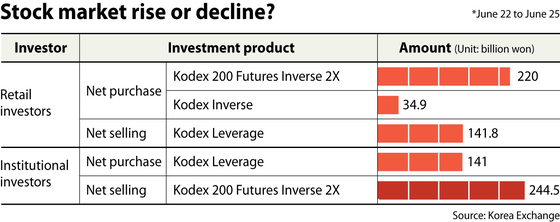Punters go for double inverse ETFs. What could go wrong?
![A board at Hana Bank's trading room in central Seoul on June 25 shows the Kospi breaking the 3,300-mark for the first time. The index closed at 3,302.84 points, up 16.74 points, or 0.51 from the previous trading day. [YONHAP]](https://koreajoongangdaily.joins.com/data/photo/2021/06/28/baf97f62-b1b6-4545-824b-087ca1b50814.jpg)
A board at Hana Bank's trading room in central Seoul on June 25 shows the Kospi breaking the 3,300-mark for the first time. The index closed at 3,302.84 points, up 16.74 points, or 0.51 from the previous trading day. [YONHAP]
Having been crushed in recent months, so-called ant investors are now betting that stocks will fall.
And they are betting big.
One 33 year old invested 36-million-won ($32,000) in a double inverse ETF. The investment offers two won for each won stocks decline. If the index drops one percent, the investor gains two percent.
On the day the investor made his investment, the Kospi broke the 3,300-mark for the first time, hitting an all-time high of 3,302.84, up 16.84 points, or 0.51 percent.
“One move could help you win big,” the investor said. “I plan on selling it when the Kospi falls near the 3,200 mark.”
The index closed at 3,301.89 points on Monday, down 0.03 percent.
According to Korea Exchange, individual investors bought 220-billion-won worth of “Kodex 200 Futures Inverse 2X” ETFs June 22 to June 25, when the Kospi was continuing its rally.

Only one security was purchased more by individuals.
They bought 589.7 billion won of Kakao shares.
Retail investors have been quick to sell their leveraged ETFs, which bet on an increase in prices. They sold 141.8 billion worth of “Kodex Leverage” ETFs, an investment option that gives twice the gains of Kospi’s increase.
Institutional investors are doing the opposite.
During the same period, they bought 141-billion-won worth of “Kodex Leverage” ETFs. This was their second-largest purchase, following 232.7 billion won of Samsung Electronics.
Their highest net sale was the “Kodex 200 Futures Inverse 2X” ETF, with 244.5 billion won unloaded.
Retail investors believe stock indexes already reached their short-term highs and will soon fall. With the Kospi hitting new highs 14 times this year and setting an all-time record on June 25, the inverse ETF prices plummeted. Individual investors then rushed to purchase the ETFs at a low price.
U.S. Federal Reserve's possible shift towards tightened monetary policy is another reason investors are expecting stocks to fall.
“The U.S. stock market has been hitting record highs, and so did the Kospi, making investors think that prices will soon be corrected,” said Jun Gyun, a senior analyst at Samsung Securities.
Retail investors have made their bets, but experienced losses last week – although not big. The Kospi continued its winning streak June 22 to 25, but only rose 1.9 percent. During the same period, “Kodex 200 Futures Inverse 2X” ETF fell 4.2 percent.
Unlike individual investors, analysts are more optimistic about the market. They expect vaccine rollouts to boost economic growth and overall stock prices.
“The Kospi will rise once again in the third quarter because businesses are increasing their profits and pressures on inflation and interest rate hikes will be eased,” said Lee Kyung-min, an analyst at Daishin Securities.
Analysts expressed concerns regarding the recent hype for inverse ETFs.
“In a non-trending volatile market in which indexes continue to fluctuate, [the ETF] can be affected by compounding risk, lowering overall gains,” said Pyeon Deuk-hyeon of NH Investment & Securities.
BY HWANG EUI-YOUNG [lee.taehee2@joongang.co.kr]










with the Korea JoongAng Daily
To write comments, please log in to one of the accounts.
Standards Board Policy (0/250자)